The cardinal tetra (Paracheirodon axelrodi) is renowned for its stunning beauty and vibrant colors, making it a favorite among aquarium enthusiasts. These dazzling fish are most impressive when kept in a school, where their brilliant red and blue hues create a breathtaking spectacle in a well-planted aquarium.
Cardinal tetras are delicate and require meticulous care to maintain their striking appearance. To ensure their health and vibrant coloration, it’s crucial to provide them with an environment that closely mirrors their natural habitat. This includes selecting compatible tank mates, maintaining optimal water conditions, and offering a balanced diet.
In a lush, densely planted tank, a school of cardinal tetras can transform your aquarium into a vibrant aquatic landscape. However, their delicate nature demands careful attention to detail. Ensuring proper water quality, a suitable tank setup, and a nutritious diet will help these beautiful fish thrive and showcase their full splendor.
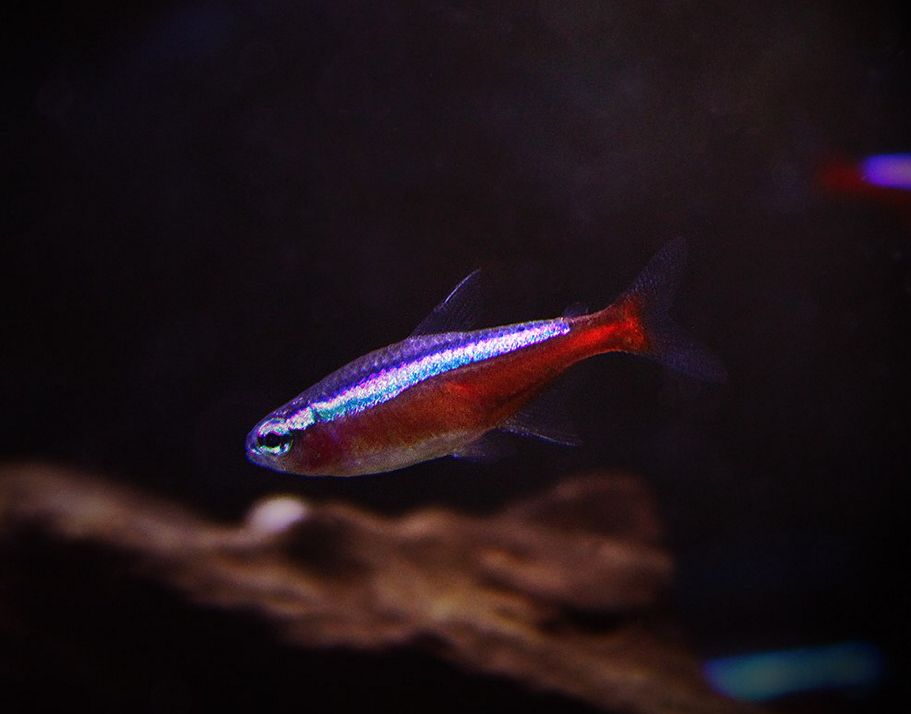
Contents
Habitat in the wild
The cardinal tetra (Paracheirodon axelrodi, Schultz, 1956) is a stunning member of the Paracheirodon genus, which also includes the neon tetra (Paracheirodon innesi, Myers, 1936) and the green neon tetra (Paracheirodon simulans, Géry, 1963). Renowned for their vibrant colors and active schooling behavior, cardinal tetras are a popular choice for aquariums.
Native to the Amazon River basin in South America, cardinal tetras thrive in the middle layers of the water column within the dense, floodplain forests and tributaries of the Orinoco and Rio Negro rivers. During the annual floods, these fish migrate from the river channels into the expansive floodplain areas, where they find ample food, breeding grounds, and shelter. As the waters recede, they return to the river systems for the dry season.
In their natural habitat, cardinal tetras are found in richly vegetated environments, such as the forest floor during floods and the shallow, shaded regions near riverbanks. The water in these areas is often darkened by tannins leached from rotting plant matter, creating a “black water” environment that is both acidic and soft. The typical water conditions include temperatures between 23 to 27°C and a hardness of 5 to 12 dH, with a pH range of 5.0 to 6.5.
Understanding these natural conditions is essential for replicating an ideal habitat for cardinal tetras in an aquarium. Providing similar water conditions and a well-planted environment will help ensure their health and vibrant coloration.
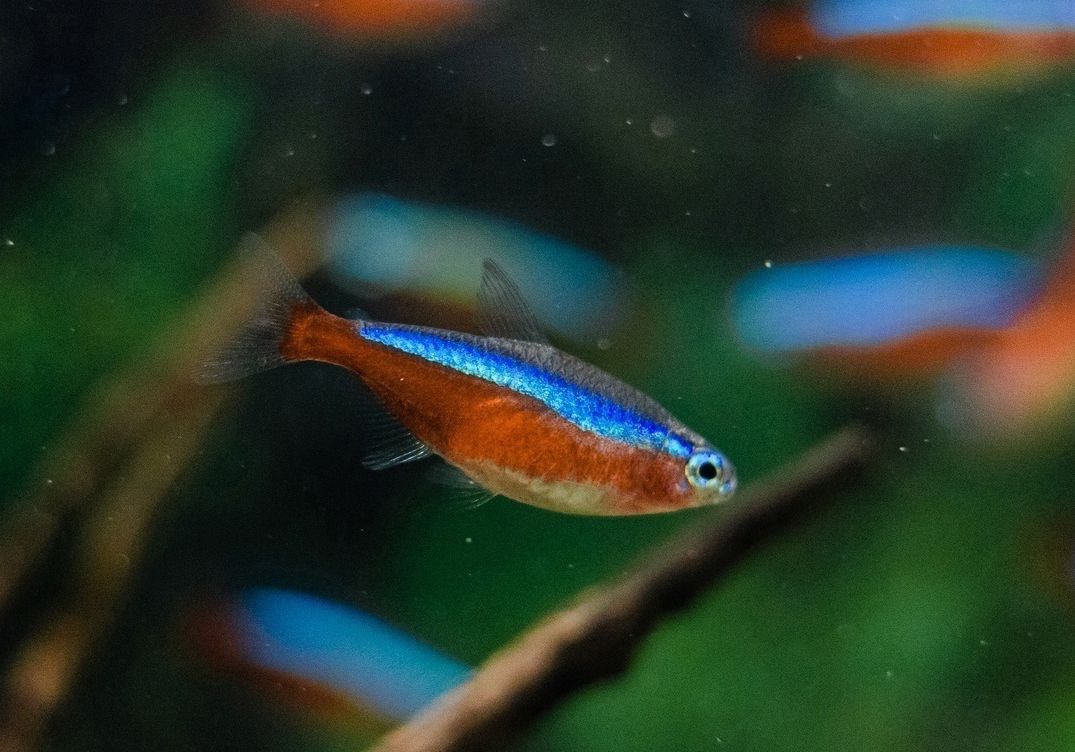
Description
Color
Cardinal tetras are small fish renowned for their striking and vivid coloration. Their backs are adorned with a subtle olive and beige hue, creating a natural backdrop for their most captivating features. A brilliant, iridescent blue stripe extends from their eye to the base of the dorsal fin, shimmering with a neon glow. Beneath this electrifying blue stripe, a wide, vibrant red band runs along the length of their body. The lower half of the cardinal tetra is a shimmering silver, enhancing their overall brilliant appearance.
Size
Cardinal tetras are relatively small fish, typically reaching an average length of about 1.5 inches (3.8 centimeters). Males are usually slightly smaller and more slender compared to females. While individual sizes can vary, cardinal tetras generally remain within this size range throughout their lives.
Lifespan
Cardinal tetras typically have an average lifespan of 3 to 5 years in captivity. With proper care and optimal conditions, some individuals can live up to 6 years. In the wild, however, their lifespan is generally shorter and rarely exceeds two years.
| Characteristic | Description |
|---|---|
| Scientific Name | Paracheirodon axelrodi |
| Common Name | Cardinal Tetra |
| Native Range | Amazon River basin in South America |
| Size | Up to 1.5 inches (3.8 cm) in length |
| Coloration | Bright blue body with a red stripe and silver belly |
| Behavior | Schooling, peaceful |
| Water Parameters | Soft, slightly acidic water (pH 5.5-7.0) |
| Temperature | 73°F – 81°F (23°C – 27°C) |
| Diet | Flakes, pellets, live or frozen small foods |
| Breeding | Challenging, egg scatterers |
| Natural Habitat | Slow-moving or stagnant blackwater streams |
| Preferred Habitat | Densely vegetated areas near riverbanks |
| Water Conditions | Soft, acidic water with low light levels |

Cardinal tetra vs neon tetra
The cardinal tetra (Paracheirodon axelrodi) and the neon tetra (Paracheirodon innesi) are both popular freshwater fish species known for their vibrant colors and schooling behavior. Although they share some similarities, they also have distinct differences:
- Species Identification: Despite their similarities, cardinal tetras and neon tetras are separate species. The cardinal tetra is sometimes referred to as the red neon tetra, but this name can be misleading.
- Temperature Tolerance: Neon tetras generally have a slightly broader temperature tolerance than cardinal tetras. Neon tetras can handle cooler temperatures better, making them a bit more adaptable to varying conditions.
- Coloration: Both species feature striking blue bodies with red stripes. However, the cardinal tetra has a more pronounced coloration. Its bright-red stripe extends all the way to the base of its tail, while the neon tetra’s red stripe is shorter, extending only halfway along its body.
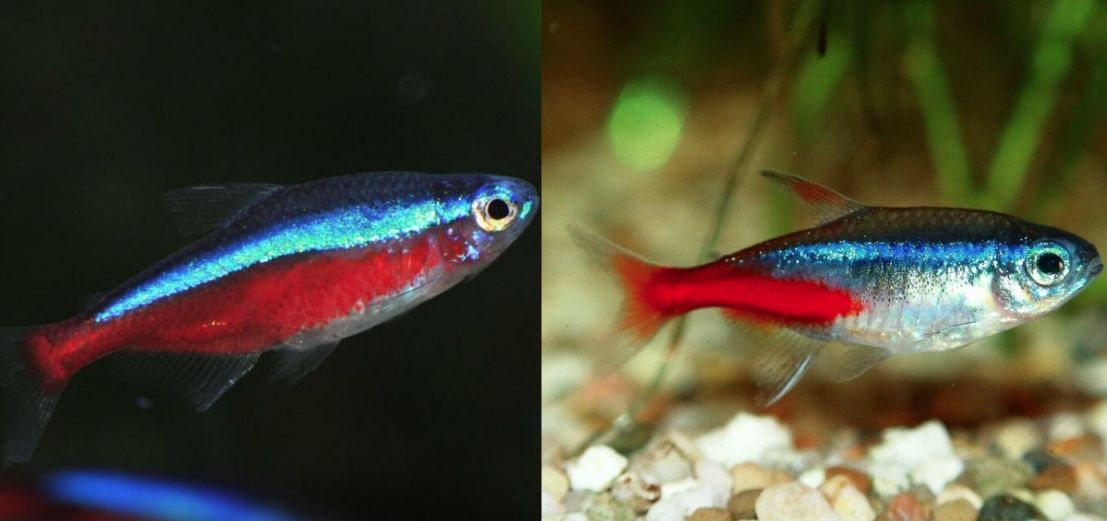
| Characteristic | Cardinal Tetra | Neon Tetra |
|---|---|---|
| Scientific Name | Paracheirodon axelrodi | Paracheirodon innesi |
| Native Range | Amazon River basin in South America | South America (Brazil, Colombia) |
| Size | Up to 1.5 inches (3.8 cm) in length | Up to 1.5 inches (3.8 cm) in length |
| Coloration | Bright blue body with red stripe | Bright blue body with partial red stripe |
| Red Stripe | Extends from middle to base of tail | Extends halfway from middle of the body |
| Behavior | Schooling, peaceful | Schooling, peaceful |
| Water Parameters | Soft, slightly acidic (pH 5.5-7.0) | Soft, slightly acidic (pH 5.0-7.0) |
| Temperature | 73°F – 81°F (23°C – 27°C) | 70°F – 81°F (21°C – 27°C) |
| Diet | Flakes, pellets, live or frozen foods | Flakes, pellets, live or frozen foods |
| Lifespan | 3-5 years (can live longer with care) | 3-5 years (can live longer with care) |
| Distribution | Broader range in Amazon basin | Limited to Brazil and Colombia |
Difficulties in keeping
Caring for cardinal tetras (Paracheirodon axelrodi) can be more challenging compared to neon tetras due to their sensitivity to water conditions. Cardinal tetras are quite delicate and require stable water parameters to thrive. They are highly sensitive to changes in water quality and purity, which can lead to illness or even death if conditions fluctuate. Because of these demands, cardinal tetras are best suited for experienced aquarists rather than beginners.
When kept in soft, acidic water—mimicking their natural “black water” habitat—tetras display more vibrant coloration. They also look particularly stunning in a well-planted tank with soft lighting and a dark substrate, which enhances their natural beauty.
In a stable and well-maintained environment, cardinal tetras can live a long, healthy life and resist diseases. However, in a tank with unstable conditions, their health can deteriorate quickly. Additionally, like neon tetras, cardinal tetras are susceptible to neon tetra disease (NTD), which can further complicate their care.
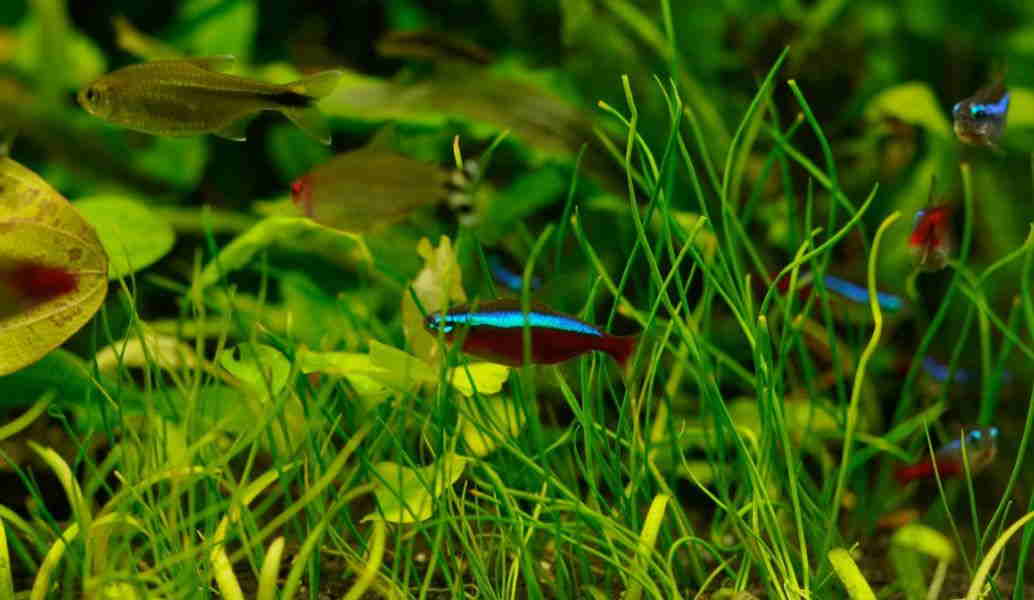
Diet
In their natural habitat, cardinal tetras primarily feed on small insects and invertebrates. Studies of their gastrointestinal contents from wild specimens reveal that they are micropredators, with their diet mainly consisting of zooplankton and bloodworms.
In the aquarium, tetras are relatively easy to feed and are not particularly demanding. They readily accept a variety of foods, including live, frozen, and artificial options. High-quality flake or pellet foods designed for tropical fish can form the staple diet for these tetras. Given their small mouths, it’s important to provide small-grained food to ensure they can consume it easily.
Occasional treats of freeze-dried foods such as daphnia, tubifex worms, or bloodworms can also be offered. These treats retain much of their nutritional value and offer a different texture and flavor, which can help diversify the tetras’ diet.
A varied diet is essential for meeting the nutritional needs of cardinal tetras. Offering a mix of high-quality flake or pellet foods along with occasional live or frozen foods will help ensure they receive a balanced diet. Feed them small amounts multiple times a day, only giving them what they can consume within a few minutes. This approach helps prevent overfeeding and maintains water quality.
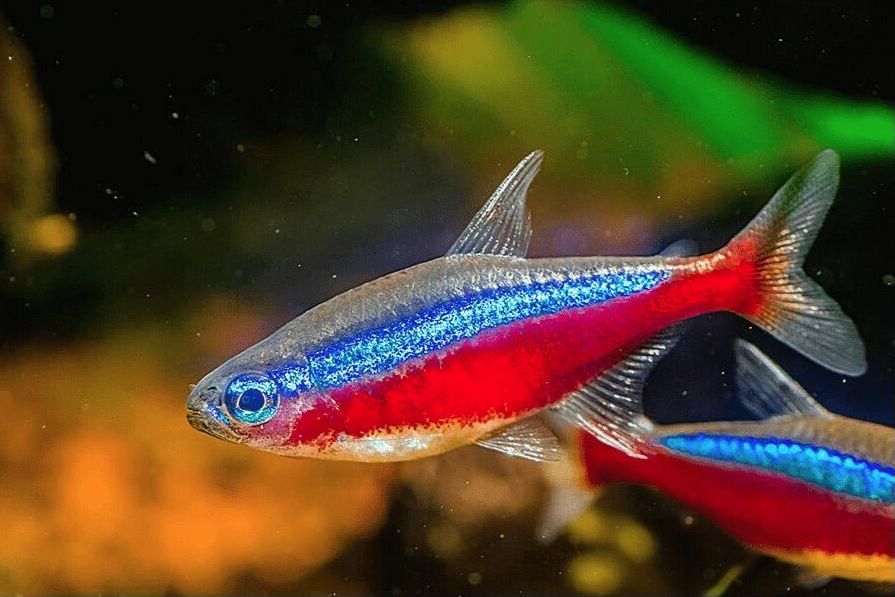
Care and keeping in a tank
Tank size
The cardinal tetra is a schooling, active, and completely peaceful fish. To showcase their natural behavior and vibrant colors, it’s best to keep them in groups of at least 10 individuals. In a properly sized school, cardinal tetras exhibit enhanced activity and vivid coloration.
Given their active nature, it’s crucial to provide ample swimming space. While a 10-gallon (38 liters) tank can accommodate a small group of cardinal tetras, larger tanks are generally preferable. A larger tank offers more swimming space, greater stability in water parameters, and allows for a more natural and visually appealing environment with space for plants, decorations, and other tank inhabitants.
For a larger school of tetras or a community tank with other fish species, a tank size of 20 to 30 gallons (75 to 113 liters) or more is recommended. This size ensures adequate room for swimming and helps maintain stable water conditions.
Additionally, since cardinal tetras are quite active and prone to jumping, it’s important to have a secure lid on the tank to prevent them from escaping.
Water parameters
To ensure the health and well-being of cardinal tetras, maintain a comfortable water temperature between 73–81°F (23–27°C). Perform a 20% water change weekly to keep the tank clean and stable. Optimal water conditions for cardinal tetras include a temperature range of 73–81°F (23–27°C), a pH level between 6.0 and 7.0, and soft water with a hardness level between 1 to 5 dGH (German degrees of hardness) or 18 to 90 ppm (parts per million).
Cardinal tetras are highly sensitive to ammonia and nitrate levels, so it’s crucial to avoid placing them in newly established tanks that have not yet achieved biological stability. Before introducing cardinal tetras, ensure the aquarium is properly cycled and the water parameters are stable. Consistent and stable water conditions are key to keeping these fish healthy and stress-free.
Tank setup: decorations and plants
The lights should be of moderate intensity with lots of plants in the tank. It’s better to shade that tank with fluctuates. Although the fish needs to have some shelter in the tank, it also needs some open space for swimming.
A thickly planted tank with some free space in the middle will be an ideal one for such a fish. With the help of tank decorations, you can create many shelters.
When decorating the tank, it’s better to make it look natural, i.e., use natural decorations: stones and snags. It’s better to use sand or small pebbles as a tank substate. However, it doesn’t matter much for the fish. Cardinal tetras swim in the middle water layer, and they don’t pick up food from the bottom.
A school of cardinal tetras will look good in a sickly-planted tank. Adding live plants can help create a natural environment and provide hiding places and shade for the fish. Live plants can also contribute to the water chemistry by releasing tannins and lowering the pH slightly. You can put the plants along the back and side walls of the tank and leave a space in the middle for the fish to swim. You can use any popular tank plants: amazon sword, cryptocorynes, hornwort, vallisneria.
Filtration
Install a filter with adequate capacity for your tank, but avoid strong water flow as cardinal tetras prefer calm waters. A canister filter is an excellent choice, as it provides efficient filtration and allows beneficial bacteria to thrive, breaking down ammonia and nitrates into less toxic compounds. This will help maintain a stable and healthy environment for your tetras.
Tank mates
Cardinal tetras are generally peaceful and thrive in community aquariums. Like other tetra species, they enjoy being in groups and are best kept in schools of at least 10 individuals. In a well-established school, cardinal tetras exhibit their most vibrant coloring and feel more comfortable, making them a stunning addition to any aquarium.
Here’s a list of potential tank mates for cardinal tetras:
- Other Peaceful Tetras:
- Neon tetras (Paracheirodon innesi)
- Glowlight tetras (Hemigrammus erythrozonus)
- Ember tetras (Hyphessobrycon amandae)
- Black neon tetra
- Emperor tetra
- Flame tetra
- Red-eyed tetra
- Serpae Tetra
- Rasboras:
- Harlequin rasboras (Trigonostigma heteromorpha)
- Phoenix Rasbora
- Lambchop rasboras (Trigonostigma espei)
- Corydoras Catfish:
- Dwarf Cichlids:
- Apistogramma species (e.g., Apistogramma cacatuoides, Apistogramma agassizii)
- Mikrogeophagus ramirezi (Ram cichlid)
- Small Livebearers:
- Endlers (Poecilia wingei)
- Least killifish (Heterandria formosa)
- Guppies (Poecilia reticulata) (males without long fins to prevent fin nipping)
- Peaceful Dwarf Gouramis:
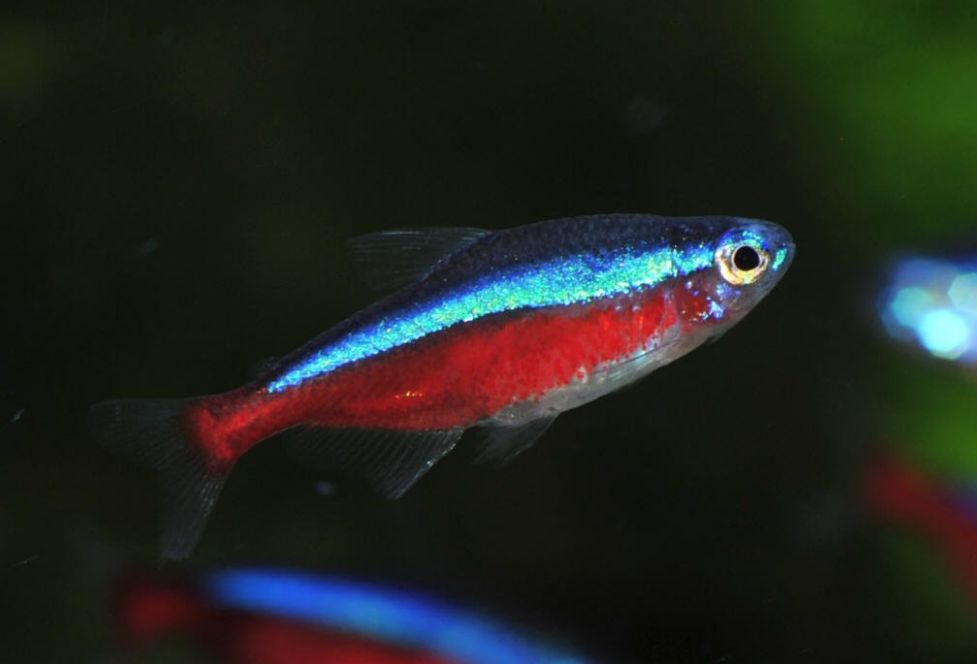
Gender differences: male vs female
Gender dimorphism is minimal, much like in other species of this genus. Generally, there are no distinct differences in size, shape, or coloration between males and females.
In aquariums, where cardinal tetras grow to about 3.5 to 5 cm (compared to up to 2.5 cm in the wild), females tend to be slightly larger and rounder than males, especially during spawning periods. During breeding, female cardinal tetras may exhibit a noticeably rounder belly and a more prominent pink or reddish hue on their lower abdomen.
Breeding
Breeding may be performed both in couples and in school. Usually there 2-3 males for 1 female in a tank. In case of the cardinal tetra couples breeding you may need a tank about 0,5 gallons capacity, if the breeding will be of schooling type the tank capacity should be about 1 gallon.
The water level in a spawning pond should be about 30 cm. Water hardness is 1-2°dH, since if the water is harder the eggs may not get fertilized; pH= 5 – 5,5 and water temperature about 24 -26 °C.
The water should be disinfected by means of ozonizer or ultraviolet lamp. The spawning net and plants with small leaves are put on the tank bottom.
In about a week before the spawning starts it’s desirable to put males apart from females. The cardinal tetra that are to breed are kept in the water with low temperature (about 22 — 23 °C) and fed high and well. You should stop feeding the fishes the day before putting into the spawning pond.
Sometimes the spawning process is delayed for about 5-7 days.
You shouldn’t feed the fishes in the spawning tank , though there’s no sense in keeping them there more than a week. If the eggs weren’t laid during this period of time, you have to remove the fishes from the spawning tank and a few days later try to make them breed again.
The spawning starts when it gets dark and it lasts for several hours. About 300-500 transparent orange eggs appear in the tank during this time.
The tank with eggs should be shaded, since they are very sensitive to light. In 20-36 hours larva appears from the eggs. They start to swim in 5-6 days after that.
As soon as the juveniles start to swim you should start feeding them. Start feed for juveniles is infusorians and crustaceans nauplii. After you start feeding the juveniles in the tank, you have to start slow aeration of the water.
Also gradually make the water more hard, because it’s necessary for the juveniles. To do this it’s enough to add some water from the community tank into the spawning pond.
As the juveniles grow the start eating feed of larger size. During the first 2 weeks of their lives juveniles hide under the tank plants leaves.
During the 3rd week a blue stripe appears along their body. At about the age of 1 month and a half they have a shape and coloring the same as the adult cardinal tetra has and they can be transferred to the community tank.
Diseases
They are susceptible to various diseases, similar to other aquarium fish. Here are some common ailments that can affect them:
Neon Tetra Disease (NTD): This highly contagious disease, caused by the parasitic microorganism Pleistophora hyphessobryconis, affects neon tetras and other fish species. Infected fish often display pale coloring. Unfortunately, there is no cure for NTD, and affected fish are typically euthanized to prevent the spread of the disease.
Ich (Ichthyophthirius multifiliis): Commonly known as “white spot disease,” ich is characterized by white spots on the body and fins of the fish. Infected fish may also scratch against objects in the tank. Ich can be treated with medications designed to target and kill the parasites.
Fin Rot: This bacterial infection affects the fins and can be caused by poor water quality, stress, or physical injuries. Symptoms include frayed or eroded fins, and in severe cases, the infection may spread to the fish’s body. Treatment involves improving water conditions and administering appropriate antibiotics.
Velvet Disease (Oodinium): Velvet is caused by the Oodinium parasite and is marked by a gold or rusty dust-like coating on the fish’s body, along with symptoms such as rapid breathing and lethargy. Specific medications designed to treat parasitic infections are used to combat velvet disease.
Fungal Infections: Fungal infections often occur in fish with open wounds or injuries. Symptoms include fuzzy or cotton-like growths on the affected areas. Treatment typically involves antifungal medications and addressing the underlying cause of the infection.
Bacterial Infections: Cardinal tetras can also be prone to bacterial infections, such as columnaris (Flexibacter columnaris) and bacterial septicemia. Symptoms may include open sores, ulcers, red streaks, or swollen body parts. Treatment involves appropriate antibiotics and improving water quality.